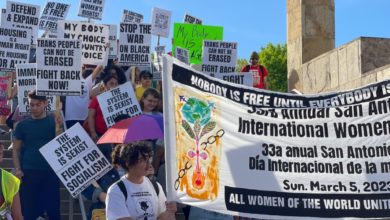Single mothers, who number more than 10 million in the United States, face many challenges.
Today, 70 percent of single mothers work outside the home. But many working class single mothers are living pay
 |
For single mothers, finding a job earning enough to make ends meet can be especially difficult. They can be viewed as less reliable due to child care issues. Bosses view a single mother as a worker who is more likely to miss work in order to care for a sick child. Racism can make it even harder for single mothers from oppressed communities to get a job.
There is little relief from the government for single mothers who are unemployed. The slashing of welfare entitlements under the Clinton administration kicked millions of families off federal aid.
Single moms are now required to work 20 hours per week in order to receive assistance. Welfare rules also only enable a mother on welfare to go to college for one year, making completing a degree nearly impossible.
According to the Urban Institute, the average wage for single moms after leaving welfare is $8 per hour, or $14,000 per year for a 35-hour work week.
If a single mother is able to find work, securing adequate day care is a huge obstacle. It is a huge expense. Average child care costs range from $4,000 to $10,000 per year. The Census Bureau found that families with less that $14,000 annual income spend more than 25 percent of their income on child care.
The new welfare laws included subsidies for child care, but there is an extreme shortage of child care providers for people receiving welfare assistance. According to the Children’s Defense Fund, at least 550,000 children who qualified for federally subsidized child care are on waiting lists for child care.
A Department of Health and Human Services study found that one out of seven children are receiving the subsidized child care for which they are eligible under federal guidelines. The federal Head Start preschool program serves less than 60 percent of the eligible children. Less then five percent of the eligible toddlers are in the Early Head Start Program.
As many states face budget deficits, child care subsidies have been cut, leaving thousands of low-income single mothers without access to child care. In some cases, mothers feel forced to leave their children in unsafe conditions in order to earn money for food and shelter and qualify for desperately needed but outrageously low welfare assistance.
Another example of the difficulties is that employers are not required to ensure that workers’ schedules accommodate their child care responsibilities.
In Connecticut, it is law that a child cannot be in day care for longer than 10 hours per day on a regular basis. If this happens, the day care provider is required to report the parent to the Department of Family Services.
But the law ignores reality for thousands of working-class women. If a parent is required to work eight hours a day and take a one hour lunch break, the work day is nine hours, leaving just thirty minutes to get to and from the day care facility.
For many single mothers, working overtime is not an option. This can lead workers to being passed up for promotions and increase the likelihood of being fired. Under these circumstances, it is also easier for bosses to pit workers against each other.
Socialist system offers real solutions
Solutions to the problem of day care access for working class families, especially single mothers, can be found by looking at examples of socialist countries’ efforts. Workers’ states have ensured that care for children is the responsibility of the whole society, not the sole burden of struggling parents.
These countries have put a high priority on child care as central to reaching women’s equality as well. They have shown that child care is a right that can be provided when resources are used to meet people’s needs, and not to make profits for the rich.
In the Soviet Union, women workers had the right to a job as well as a year of paid maternity leave after childbirth. Child care was free.
In Cuba, just one year after the Cuban Revolution, the Federation of Cuban Women was founded to address women’s issues. It has been instrumental in establishing paid maternity leave, free day care and extended educational opportunities, along with many other benefits.
Cuba has over 1,000 child care facilities on the island of 11.4 million. Day care centers have on-site doctors and nurses. Eye, ear and dental exams are done free at the centers. Parents can receive one year of paid maternity leave whether or not the two are married.
A fighting campaign for the right to day care, jobs, education and other basic human rights is needed now in the United States. Working-class mothers who overcome incredible obstacles to raise their children have the power to lead this struggle. It is time to stand up and demand what is long past due.






